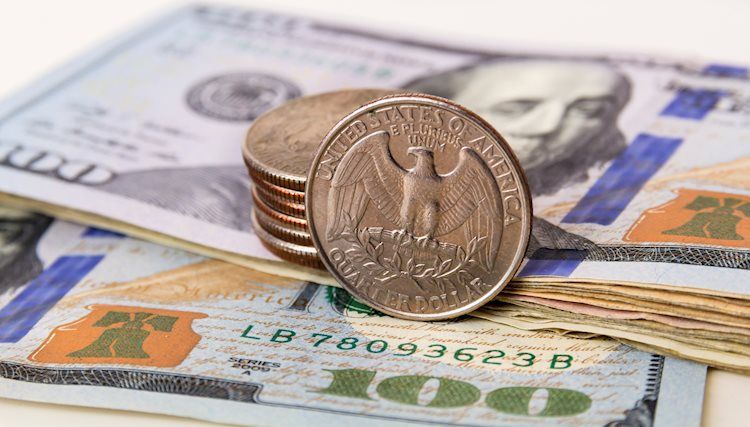- DXY Index stands positively at 104.95, reflecting a noticeable gain for the day.
- Investors focus on incoming data amidst speculation of an easing cycle commencing in June.
- ISM PMI readings from March beat expectations.
- Markets await Nonfarm Payrolls, Average Hourly Earnings, and Unemployment Rate from March to gauge insights into the economy’s health.
The US Dollar Index (DXY) trades at 104.95 on Monday morning, reflecting some gains. The strong ISM business activity report from March, showing the highest growth since September 2022, could discourage the Federal Reserve (Fed) from rushing to the start of the easing cycle. Labor market data to be released later this week will shape expectations.
The US economy appears steady with the Fed’s stance treading a cautious path. Despite upward revisions in inflation projections, the Fed, under Powell’s guidance, refrains from overreacting to short-term spikes in inflation. The speculated start of an easing cycle in June remains dependent on incoming data.
Daily digest market movers: DXY buoyed by robust business activity, hawkish Fed bets
- Institute for Supply Management (ISM) report shows business activity for March improved for the first time since September 2022, indicating a robust economy.
- Manufacturing Purchasing Managers Index (PMI) hit 50.3 in March, surpassing projected figures of 48.4 and appreciably exceeding February’s reading of 47.8.
- ISM report’s Prices Paid Index rose to its highest level of 55.8 YoY since 52.5 in August 2022.
- An improving economy might discourage the Fed from relaxing its monetary policy.
- As a reaction to ongoing US economic resilience, the odds for a rate cut in June’s meeting dropped from 85% to around 65%.
- In the bond market, US Treasury bond yields surged. The 2-year yield is at 4.71%, the 5-year yield at 4.33%, and the 10-year yield at 4.33%, all showing sharp increases and reflecting a boost in hawkish bets.
- Pertinent US labor market data such as Average Hourly Earnings, Nonfarm Payrolls, and the Unemployment Rate will provide a vital understanding of the health and trends of the country’s workforce.
DXY technical analysis: DXY bears recede, bulls gain control
The technical indicators on the daily chart reflect an increasing buying momentum for DXY. The Relative Strength Index (RSI) is in positive territory and exhibits a positive slope, which is generally known as a bullish signal. Furthermore, the Moving Average Convergence Divergence (MACD) indicators display rising green bars, amplifying the emphasis on bullish momentum.
Additionally, the index position above the 20, 100, and 200-day Simple Moving Averages (SMAs) adds arguments for a positive technical outlook for the USD.
Fed FAQs
Monetary policy in the US is shaped by the Federal Reserve (Fed). The Fed has two mandates: to achieve price stability and foster full employment. Its primary tool to achieve these goals is by adjusting interest rates. When prices are rising too quickly and inflation is above the Fed’s 2% target, it raises interest rates, increasing borrowing costs throughout the economy. This results in a stronger US Dollar (USD) as it makes the US a more attractive place for international investors to park their money. When inflation falls below 2% or the Unemployment Rate is too high, the Fed may lower interest rates to encourage borrowing, which weighs on the Greenback.
The Federal Reserve (Fed) holds eight policy meetings a year, where the Federal Open Market Committee (FOMC) assesses economic conditions and makes monetary policy decisions. The FOMC is attended by twelve Fed officials – the seven members of the Board of Governors, the president of the Federal Reserve Bank of New York, and four of the remaining eleven regional Reserve Bank presidents, who serve one-year terms on a rotating basis.
In extreme situations, the Federal Reserve may resort to a policy named Quantitative Easing (QE). QE is the process by which the Fed substantially increases the flow of credit in a stuck financial system. It is a non-standard policy measure used during crises or when inflation is extremely low. It was the Fed’s weapon of choice during the Great Financial Crisis in 2008. It involves the Fed printing more Dollars and using them to buy high grade bonds from financial institutions. QE usually weakens the US Dollar.
Quantitative tightening (QT) is the reverse process of QE, whereby the Federal Reserve stops buying bonds from financial institutions and does not reinvest the principal from the bonds it holds maturing, to purchase new bonds. It is usually positive for the value of the US Dollar.
